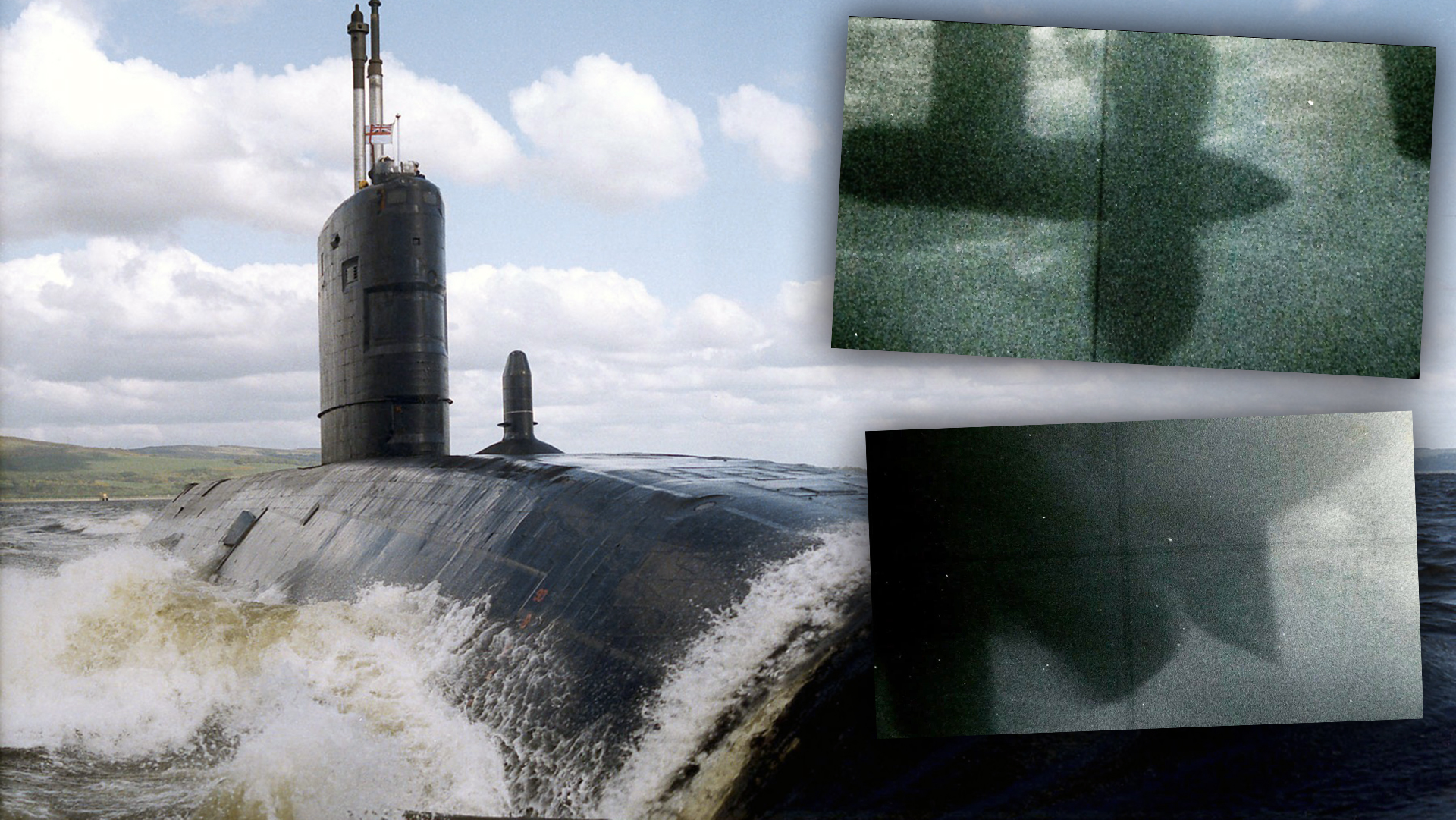Good to read a story about a sub in its natural habitat... Underneath a carrier.Properly falls under the "sea story" heading ...

How A British Submarine Spent Hours Under A Russian Aircraft Carrier
A Cold War British nuclear sub sneaked into a Soviet naval exercise and took closeup underwater pictures of Russia’s new aircraft carrier.www.thedrive.com
You are using an out of date browser. It may not display this or other websites correctly.
You should upgrade or use an alternative browser.
You should upgrade or use an alternative browser.
New Fast-Attack Nuclear Submarines to be Named Arizona and Oklahoma
- Thread starter KathyV
- Start date
Please register or login
Welcome to ScubaBoard, the world's largest scuba diving community. Registration is not required to read the forums, but we encourage you to join. Joining has its benefits and enables you to participate in the discussions.
Benefits of registering include
- Ability to post and comment on topics and discussions.
- A Free photo gallery to share your dive photos with the world.
- You can make this box go away
Don't know if this is right forum, but a good read anyway.
Well it is for some in Australia: US should send a jointly operated nuclear submarine to Australia, congressman says
Well it is for some in Australia: US should send a jointly operated nuclear submarine to Australia, congressman says
We don't have any boats to share or spare. I also don't think we would let them train on a Seawolf or Virginia class, let alone Ohio or Colombia.Don't know if this is right forum, but a good read anyway.
Well it is for some in Australia: US should send a jointly operated nuclear submarine to Australia, congressman says
How do you tell a northern fleet sailor apart from the rest of the Soviet Navy?
He glows in the dark

 www.thedrive.com
www.thedrive.com
He glows in the dark

Rare Look At Nuclear Reactor Inside Russian Ballistic Missile Submarine
Reactors inside nuclear-powered submarines are very sensitive pieces of equipment and it's highly unusual for a navy to publicize them.
Don't know if this is right forum, but a good read anyway.
Well it is for some in Australia: US should send a jointly operated nuclear submarine to Australia, congressman says
Good way to get rid of the 688 class subs
Make it like Down Periscope and give them a Balo or Gato class and let the games begin.Good way to get rid of the 688 class subs
HalcyonDaze
Contributor
Sent that to a friend with the comment "I'd say it takes balls to be in the same compartment as a Russian nuclear reactor, but ..."How do you tell a northern fleet sailor apart from the rest of the Soviet Navy?
He glows in the dark

Rare Look At Nuclear Reactor Inside Russian Ballistic Missile Submarine
Reactors inside nuclear-powered submarines are very sensitive pieces of equipment and it's highly unusual for a navy to publicize them.www.thedrive.com

I think this probably means basing a US boat (or multiple ones) in Australia, which would remain under USN command and control but have a number of Australian sailors assigned to the crew for training and familiarization with SSN operations, particularly the reactor (somewhere Hyman Rickover is rolling in his grave, but that doesn't take much). As stated before it's not a completely new idea; back when the UK Royal Navy axed HMS Illustrious and the Nimrod MRA4 program they sent RN and RAF flight officers to USN fighter and patrol squadrons (and not just as GIBs, but carrier-qualified pilots in the former case) to keep their skills up while waiting for the MoD to replace those capabilities. We do the same; USN/USAF pilots have served on exchange tours in NATO squadrons (one of the more fascinating examples I've read about being a USAF pilot who got to fly in a Luftwaffe MiG-29 squadron, which gave him a very thorough understanding of the type's strengths and weaknesses).Don't know if this is right forum, but a good read anyway.
Well it is for some in Australia: US should send a jointly operated nuclear submarine to Australia, congressman says
The subs in question would be either Improved 688s or Virginia-class boats; I expect the latter as those are on par with what the eventual Australian SSNs are supposed to be and theoretically at least the last of the 688s should leave the fleet in the next decade (although examples like USS Boise, which sat idle for several years waiting for overhaul, might have a few more years of core/hull life to spare and serve into the mid-late 2030s).
It's just the problem getting over on how sensitive the submarine service is in terms of sharing information and allowing foreigners aboard. Think about how much is still classified from WW2 let alone early Cold War. The US is probably VERY hesitant to work with even the closest of allies. I always wondered what the British had to do to get the Poseidon missiles on their subs.Sent that to a friend with the comment "I'd say it takes balls to be in the same compartment as a Russian nuclear reactor, but ..."
I think this probably means basing a US boat (or multiple ones) in Australia, which would remain under USN command and control but have a number of Australian sailors assigned to the crew for training and familiarization with SSN operations, particularly the reactor (somewhere Hyman Rickover is rolling in his grave, but that doesn't take much). As stated before it's not a completely new idea; back when the UK Royal Navy axed HMS Illustrious and the Nimrod MRA4 program they sent RN and RAF flight officers to USN fighter and patrol squadrons (and not just as GIBs, but carrier-qualified pilots in the former case) to keep their skills up while waiting for the MoD to replace those capabilities. We do the same; USN/USAF pilots have served on exchange tours in NATO squadrons (one of the more fascinating examples I've read about being a USAF pilot who got to fly in a Luftwaffe MiG-29 squadron, which gave him a very thorough understanding of the type's strengths and weaknesses).
The subs in question would be either Improved 688s or Virginia-class boats; I expect the latter as those are on par with what the eventual Australian SSNs are supposed to be and theoretically at least the last of the 688s should leave the fleet in the next decade (although examples like USS Boise, which sat idle for several years waiting for overhaul, might have a few more years of core/hull life to spare and serve into the mid-late 2030s).
It's just the problem getting over on how sensitive the submarine service is in terms of sharing information and allowing foreigners aboard. Think about how much is still classified from WW2 let alone early Cold War. The US is probably VERY hesitant to work with even the closest of allies. I always wondered what the British had to do to get the Poseidon missiles on their subs.
Wait till we had better ones....
HalcyonDaze
Contributor
The RN never received the UGM-73 Poseidon C3 SLBM; they got the A3 version of the UGM-27 Polaris missile after the 1962 Nassau Agreement and 1963 Polaris Sales Agreement that I mentioned earlier in this thread. The UK Polaris missiles were US-made, but had UK nuclear warheads and were maintained in the UK. At the time, Polaris A3 was the newest US SLBM. When the US upgraded to the Poseidon C3 in the early 1970s, the UK attempted to acquire it, but relations had soured slightly between the US and UK and the UK instead pursued Chevaline, which replaced one of the Polaris's three reentry vehicles with a decoy system designed to confuse antimissile defenses.It's just the problem getting over on how sensitive the submarine service is in terms of sharing information and allowing foreigners aboard. Think about how much is still classified from WW2 let alone early Cold War. The US is probably VERY hesitant to work with even the closest of allies. I always wondered what the British had to do to get the Poseidon missiles on their subs.
In the late 70s/early 80s with the replacement of their Resolution-class SSBNs on the horizon, the UK announced an intent to pursue the UGM-96 Trident I C4 missile that the US was incorporating onto the early Ohio-class SSBNs and backfitting onto some of the older James Madison and Benjamin Franklin class SSBNs. When the US announced shortly thereafter that they would be developing the UGM-133 Trident II D5; the UK was offered the D5 instead (this was a mixed bag; while it was a more capable missile it was arguably more capable and more expensive than the UK needed, balanced by the UK desire to have commonality with US SSBNs). The missiles carried on the current UK Vanguard-class SSBNs are actually maintained by the US, unlike Polaris, and are part of a joint "pool" of missiles maintained by the Kings Bay Naval Base in Georgia. The warheads are UK-manufactured and fitted to the missiles in the UK.
Bear in mind that before all this, the UK nuclear sub program was built on cooperation with the USN; in the 1950s they did ASW exercises with USS Nautilus and were impressed with the capability, but Rickover being Rickover he initially refused to allow the First Sea Lord (Lord Louis Mountbatten at the time) to even inspect Nautilus. Mountbatten however was on good terms with Arleigh Burke, the USN Chief of Naval Operations at the time; not only did they manage to change Rickover's mind on giving the UK access to US reactor technology but rather than Rickover's offer to give the UK the S3W reactor design found on the Skate-class subs, Mountbatten came away in 1958 with the brand new S5W reactor as found on the Skipjack-class and all US nuclear sub classes up until the 688s. The first UK SSN, HMS Dreadnought, was basically a US-built S5W reactor and engineering/propulsion section mated to a UK-made forward section, a model I expect the eventual Australian SSNs to follow. The 1958 agreement, unlike AUKUS, also transferred enough technical information to allow Rolls-Royce to design and build their own PWR-1 submarine reactor, which was used on all subsequent UK nuclear subs up until the current Vanguard and Astute classes.
To add to my earlier point, the USN at least already sends its bubbleheads to work with the RAN; I had forgotten that the husband of one of my college classmates did an exchange tour with the RAN's Collins-class subs in Perth. The RAN's current sub fleet was refitted to use the same AN/BYG-1 combat system as the modernized 688is and the Virginia-class (previously it was the same CCS Mk2 system as the older 688s) and they use the current mods of the Mark 48 ADCAP torpedo (the current Mod 7 was actually co-developed with Australia), so they already have a lot of commonality on the "business end" of the subs.
Similar threads
- Replies
- 2
- Views
- 1,033
- Replies
- 73
- Views
- 9,133
- Replies
- 18
- Views
- 8,490



